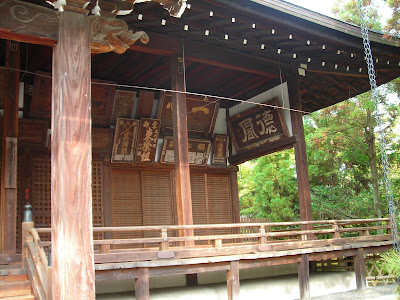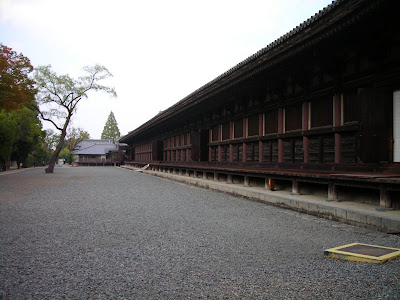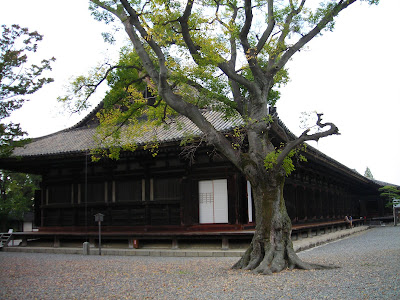Koryuji and Sanjusangendo
So on one of these days--it may have been day 4, or maybe not, I can't really remember now--I went to Koryuji. Koryuji is not really on the typical temple-tourist-trap-route for Kyoto. Although it is one of the oldest temples in Kyoto, it is not particularly shiny like Kinkakuji, it doesn't have beautiful gardens like Ginkakuji, and it doesn't have a famous rock garden like Ryoanji. It is also on the outskirts of Kyoto, in Arashiyama, the eastern mountains. When the bus dropped me off nearby, I thought I was in the wrong place at first. It looked like the suburbs, if the suburbs were in an old-fashioned Japanese town. I persevered, though, and was rewarded.
The grounds of Koryuji do not look like much, although there are a number of old buildings and such (see below). They were quiet though--no school children, no tour busses, just me and a few old Japanese people.
The grounds of Koryuji do not look like much, although there are a number of old buildings and such (see below). They were quiet though--no school children, no tour busses, just me and a few old Japanese people.

However, I was not going to Koryuji to see the grounds. Koryuji is home to a number of extremely important pieces of Buddhist art, including one of my absolute favorites (also very famous)--the Miroku Bosatsu. Miroku refers to the position it is in, a distinctive kind of thinking pose (that's what it looks like to a westerner, anyways), with the hands near the face. It is a friendly figure, dating to the 7th century, and it has an archaic smile. It is polished and shiny from the centuries, and is very beautiful. Seeing it in real life was pretty awesome. The museum at Koryuji has a lot of other great works of art as well, and is very serene and pleasant. There was almost no one there, again, and the elderly Japanese man who was taking the tickets seemed surprised to see me. Definitely worth a visit, at least for me.
At some other point, possibly during this day, and possibly not, I decided to go to Sanjusangendo. I took the bus, and found it quite quickly. You couldn't miss the enormous groups of school children. But that was okay. Sanjusangendo was another of those sites I'd learned about in Japanese art history, and always wanted to visit.
Sanjusangendo is essentially just this building in the middle of a courtyard, surrounded by a somewhat later wall. It is remarkable primarily because it does not look like a normal Japanese temple at all. Sanjusangendo means, basically, 33 bay hall, and this is what it is. Because of this, it is extremely long. In the old days, people used to do an archery contest here, shooting arrows down the long length of the hall. It is also very old, and quite impressive, in a strange way.
You can see the bays... I didn't actually count them, but I am confident there are thirty-three.

This is the back view. There were surprisingly few people wandering outside--it was nice. This is because all the people are inside. This temple is famous for holding 1001 images of the Kannon. They are lined up inside, identical statue after identical statue, vast rows of them all along this long, long hall. The images are life-size, and covered in gold. It is a profoundly impressive site, but unfortunately I cannot show it to you as you are not meant to take pictures inside. This did not prevent one deeply obnoxious German man from doing so, however. Everyone glared at him, but he didn't notice. They never do, I suppose. There are also two gorgeous images of Fujin and Raijin in the hall... very cool.

No comments:
Post a Comment